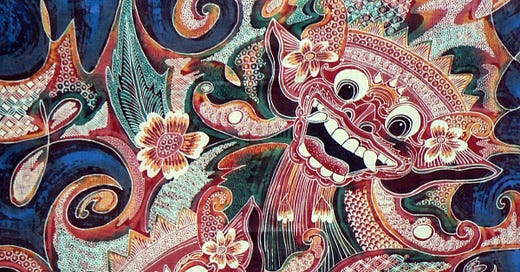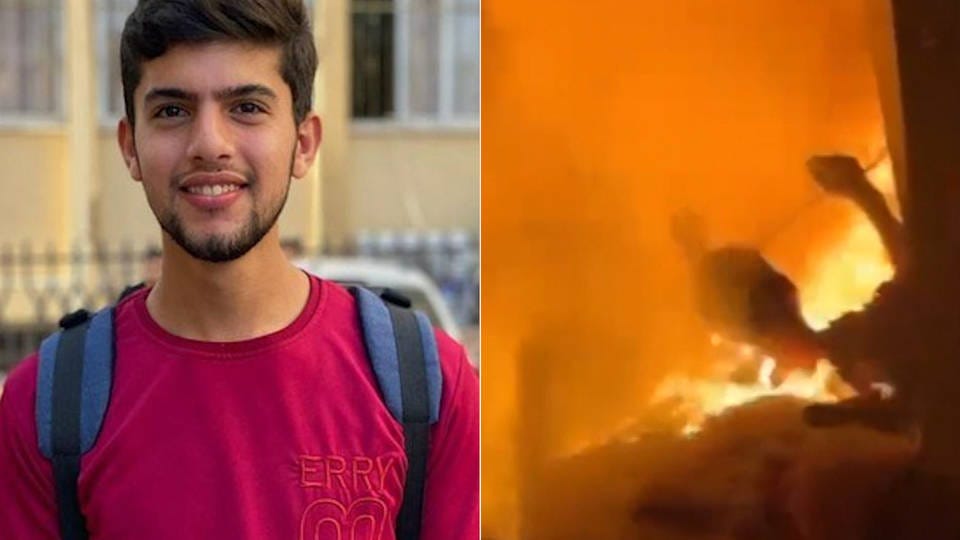I. OCTOBER 13, KALA GAN
This is the first fire. In chemical terms it is a small one: the spray of carbon dioxide and nitrogen flashing from the rifle’s barrel in chase of the bullet. A sceptre of flame fixed like a bayonet for half a heartbeat. Here: the fire in gunfire, the fire in firearm.
Gunpowder’s exothermic properties have been put to various uses for a thousand years, yet in our own lifetimes we have diligently furnished its true legacy. The signature organised action of our age is this: automatic weapons fired into civilians en masse. This, as political theorist Achille Mbembe understood, is the new nature of war. “War as a general economy no longer necessarily implies that those who have weapons oppose each other,” wrote Mbembe. “It is more likely to imply a conflict between those who have weapons and those who have none.”
On Sunday evening, October 13, the Kala Gan border crossing between Afghanistan and Iran became the latest testament to this new economy of violence. Confronted with some three hundred Afghans illegally crossing the border, Iranian forces attacked with automatic weapons and rockets. According to human rights monitor Haalvsh, the Iranian army killed some 260 Afghans, their bodies bleeding out on the barren rocks of the mountains.
This tremendous industry of slaughter could only have been accomplished by an organised group of men armed with automatic weapons. Granted this, killing at scale is easy and cheap. On full-auto an AK-47 shoots six hundred rounds per minute. A 7.62×39mm round fired from this rifle will punch through fifty centimetres of muscle and organ meat, yawing out a long blooming wound before passing out the other side. In seconds a few men firing on full-auto can saturate hundreds of people.
Videos collected by eyewitnesses show the terrible aftermath of this massacre. If reports are credited, only sixty or seventy of the Afghans who crossed into Iran were left alive. Many of the murdered were shot multiple times, and many were deliberately shot in the head. Their bodies are then covered in blankets and sheets, each with a ribbon of cloth tied around their heads to keep their jaws from slacking. Only the bleaching pale, only the gazeless eyes left slightly open, betrays their death.
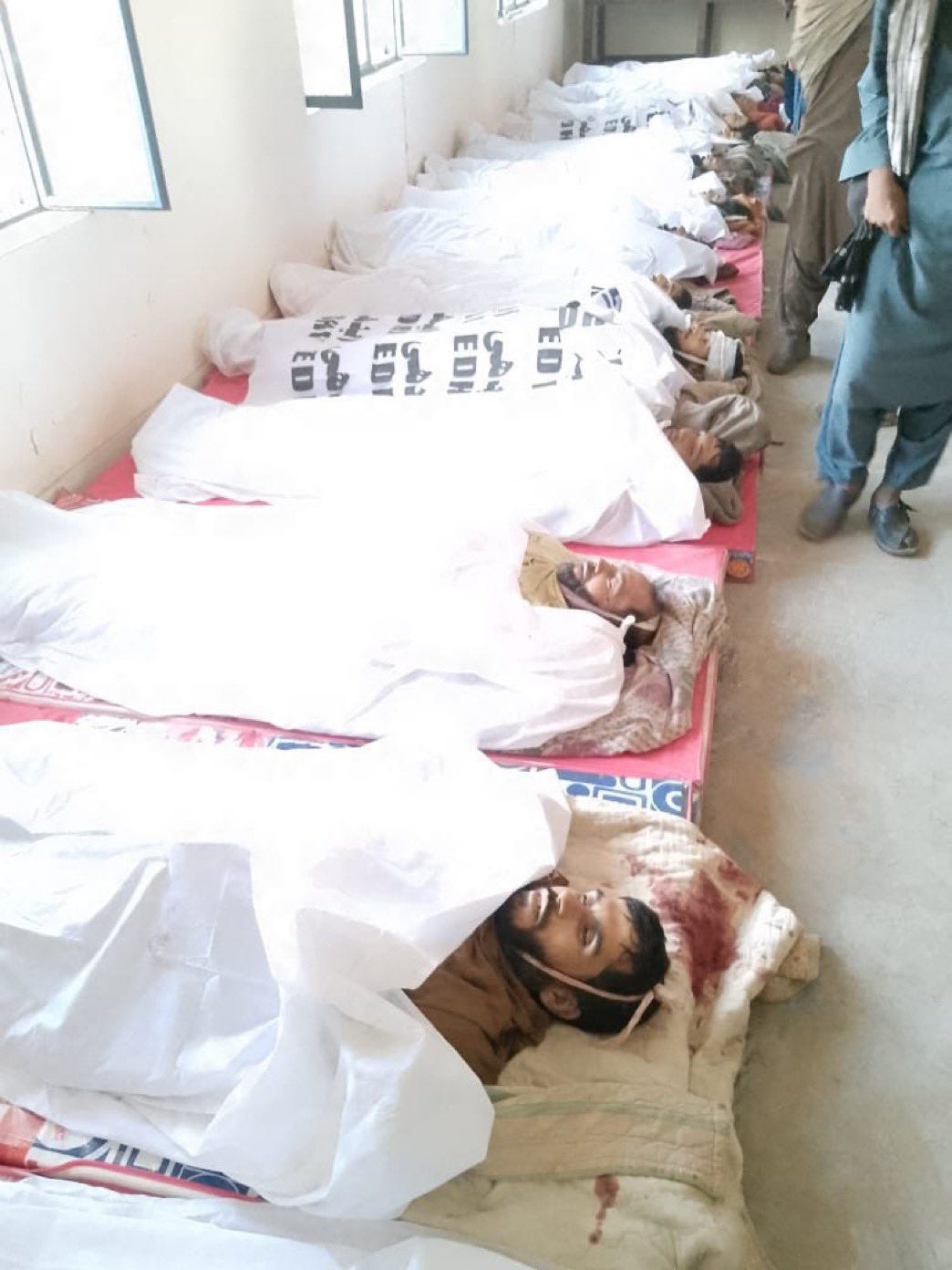
Why were nearly three hundred people apparently shot en masse in a barren corner of Sistan and Baluchestan province? Iran’s government has decided it can no longer tolerate the flow of refugees fleeing the Taliban from neighbouring Afghanistan. So it has decided to deport two million Afghans in the next six months, and to kill anybody crossing their border without permission. Like its enemy Israel, Iran has learned the value of flatly denying its atrocities without elaboration. Iran hadn’t killed anybody, said its ambassador to Afghanistan: “The Islamic Republic of Iran is determined to return the illegal asylum seekers and deal legally with their illegal entry at all border points.” The first fire is easy to hide: it leaves no craters and only the smallest of holes.
In the field of violence we’ve defined, mass shootings of people on the move stand as their own special subset. The systemised butchery of migrants in remote border regions may seem an extreme sort of crime — an accoutrement of genocide or ethnic cleansing. But it is a fairly widespread feature of the present global order. In the world’s poorer regions, writes Mbembe, we see “the establishment of an economy of coercion whose objective is to destroy ‘superfluous’ populations and to exploit raw materials.” Mass killing is now an established practice of states looking to protect their economies or ethnic makeups from hordes of undesirables on their borders.
Perhaps no country can rival Saudi Arabia in this dual mission of destroying superfluous populations and exploiting raw materials. The number of Ethiopian migrants killed by Saudi forces around the Yemen-Saudi border numbers “at least” 655 people — a spate of massacres inflicted not only with guns but rockets and grenades. “In some instances,” reports Human Rights Watch, “Saudi border guards first asked survivors in which limb of their body they preferred to be shot, before shooting them at close range.” Survivors of this fire bear witness to a cosmos untethered from rational understanding. “It is really impossible to count the number,” said one man of the corpses. “It is beyond the imagination.”
The Saudis are not alone. On 24 June 2022 the forces of Morocco and Spain shot, gassed, and beat to death at least 37 African migrants in the enclave of Melilla — which is technically European territory. Seventy-seven more migrants remain missing since that day, all “last seen in the custody of state officials”. Here ‘missing’ must be understood as euphemism. A 17-year-old boy from Sudan explained to Amnesty International what happened to his friends in Moroccan jails: “After that in the prison they were being beaten with hammers in their head until they passed away.” And neither Myanmar’s military junta nor its rebel insurgents will claim responsibility for using drones to kill as many as two hundred Rohingya refugees in Rakhine state in early August 2024. But on the muddy banks of the Naf river you can see the corpses of this beleaguered people all the same.
The first fire destroys its victims twice: first it kills the body, then, given the ease and scale of the killings, it unmakes the person. The victims of massacres are open to be killed since they are seen by their killers as subhuman, but it is the act of killing in the first place that solidifies and demonstrates their inhuman status. If you shoot 260 people at the Kala Gan border crossing and the world still spins — were they ever people to begin with? A single murder is a staggering crime, but mass murders can only be apprehended in aggregate. Their victims are not people but statistics, undesirables, illegals, units, cabbages, cockroaches.
The first fire never really happened.
II. OCTOBER 14, DEIR-AL BALAH
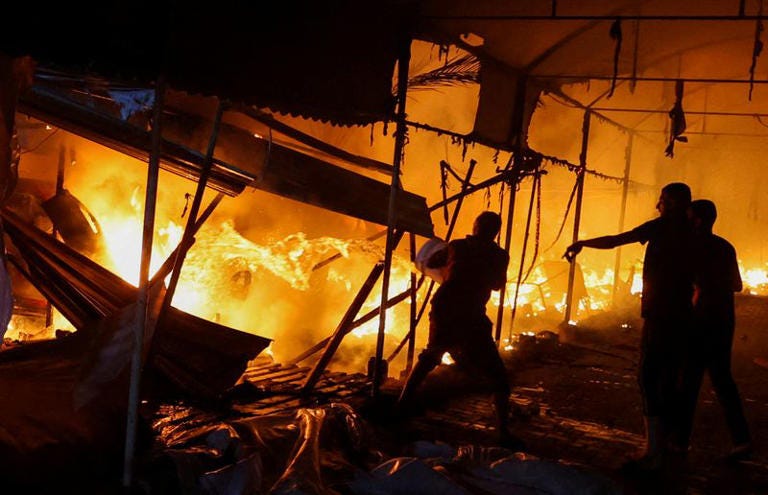
This is the second fire. Air turned to plasma; hexogen and TNT rendered pure energy at the detonation of a bomb. Slow it down and see this fire billowing outwards half as hot as the sun. Metal made shrapnel, steel turned pliant as shreds of hair. A roiling shockwave of compressed air like a battering ram. The grotesque tenderness of human flesh exposed to flame. This is the fire of bombs.
At around 1.10 in the morning of Monday October 14, the Israeli army bombed refugees sheltering around al-Aqsa Martyrs’ Hospital in Deir al-Balah in Gaza. Those the bombs did not kill they set on fire. Tents burned, the hospital burned. People burned. Burned till their skin went black and sticky, till their limbs charred and broke off their bodies like old charcoal: people burned. The wounded immolated in their hospital beds, fatally tethered by the IVs in their arms.
To live in Gaza — to be a Palestinian — is to wage daily war to avoid this fire. One discredited strategy, still widely employed by the desperate, is to shelter in places whose bombing is illegal under international law. “We ruled out that it will be bombed,” admitted Abdel-Hayy al-Dalu in the ruins of the medical compound, “since it’s a hospital.” And now he knows: legality is the flimsiest of shelters in war. In the past eight months Israel has bombed this same hospital seven times.
Drones and two-tonne bombs give the impression that wartime killing has been made scientific, surgical. In reality Israel’s genocide in Gaza is often perpetrated by killing of the most primitive and prosaic kind. Fire is the worst and oldest death. Nothing can inspire more pain in its victims or more terror in its survivors. When it is blasted in an explosion, an encampment made of plastic tarps and blankets and littered with cooking gas canisters will burn fast. But the young men, women, and children that died in the fire died all too slowly. “It wasn’t just death,” said a doctor on the scene, “it was suffering—slow, excruciating suffering. That’s what haunts me.”
Those who survived this second fire also seem reconciled to a universe whose logics of brutality they cannot fathom. “My son was being burned in front of me,” said Ahmed al-Dalu. “I accepted the will of God in every sense of the word.” That son, Shaban, burned to death on video. You can see Shaban, as he is still living and engulfed in fire, raise his arm to the inferno as if to shield out the heat. He was killed just days from his twentieth birthday. Shaban too, seemed to understand that industrialised violence can warp the fabric of reality itself. “Time feels like it’s stopped in Gaza,” he once told a reporter; “we’re stuck in a never-ending nightmare.”
“I saw death in my eyes,” said another survivor. “They took me out of the rubble. I was unconscious, bleeding, injured—all like a dream.” Imagine a violence so pure it is experienced as psychedelic. All like a dream.
Afterwards the Israeli military stated that they hadn’t really bombed defenceless civilians or a hospital at all. Rather they “conducted a precise strike on terrorists who were operating inside a command and control center in the area.” As ever it was the fault of Shaban and his dead mother, and dozens of other civilians, that they happened to be sheltering for their lives in the vicinity. The fire of bombs strips meaning from the world. Flames so hot they destroy not only the body but the personhood of the burned, for if they were people they would never have been bombed while sleeping in the shadow of a hospital.
The second fire is a fire that makes you unhuman.
III. OCTOBER 15, MAJIYA
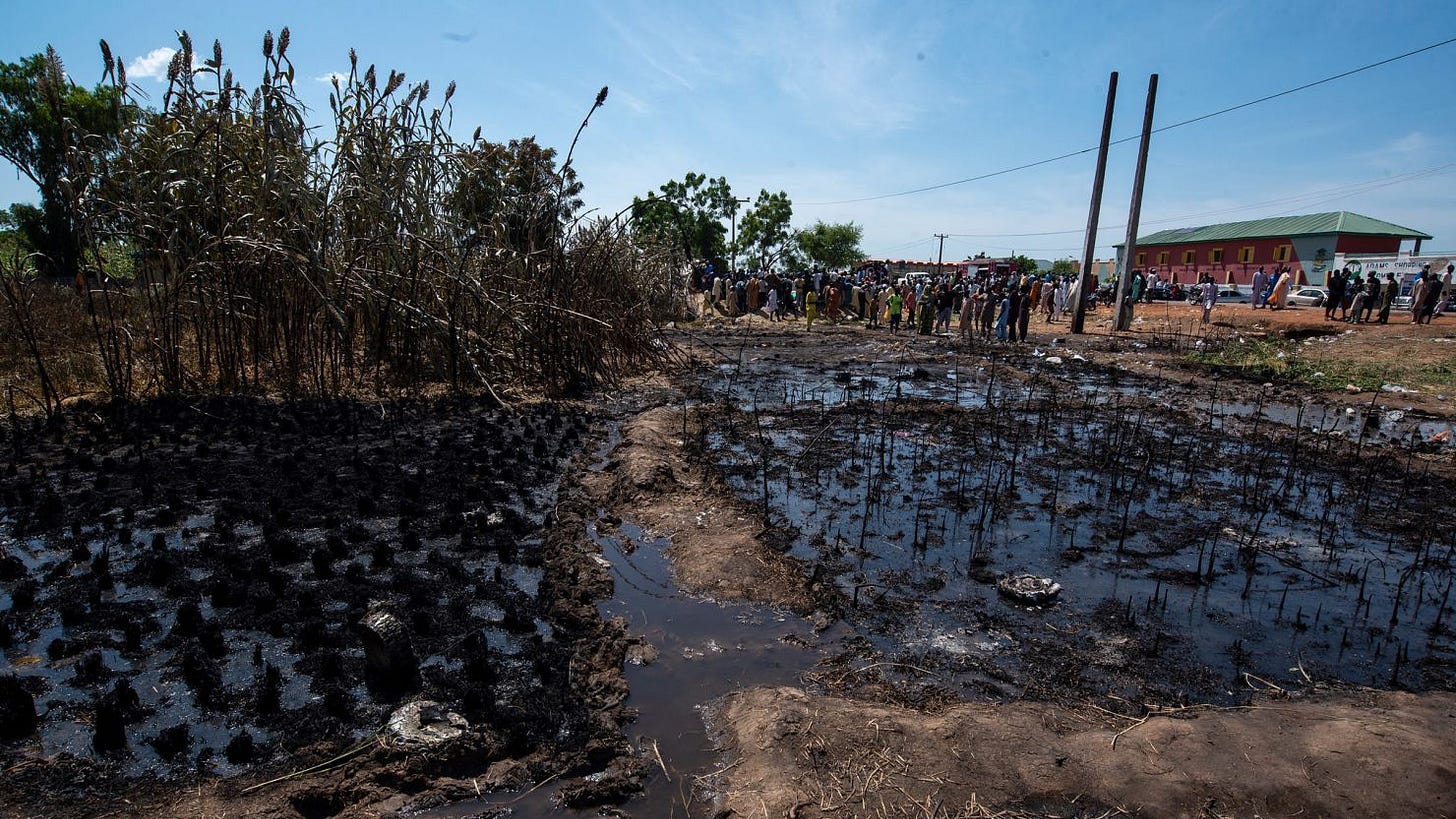
This is the third fire. It is the simplest of all our fires. Gasoline will ignite if it heated above 250 degrees celsius, and when it burns, it burns nearly eight times hotter. Given the right ratio of fuel to air, gasoline exposed to a heat source will not merely burn but explode. This, in many parts of the world, is an everyday way of dying.
Thus on Tuesday, October 15, at least 170 people in northern Nigeria burned to death when a fuel tanker exploded. Fully loaded, the tanker could carry 45,000 litres of gasoline. It was travelling east from Kano state and we can assume it was travelling fast. Near the town of Majiya the tanker veers to avoid an oncoming truck. It is late at night and utterly dark. Majiya has no streetlights. The tanker crashes, rolling to its side on the sandy berm of the highway like a beached whale. Petrol saturates the dust.
Hearing the crash, hundreds of local residents rush in. They carry canisters and buckets with them, for they are making a wager with physics and with God. They will approach the tanker and collect the petrol running into the streets of Majiya. The price of petrol is cruel; for many it outweighs the price of burning.
For an hour the town’s residents collect their free petrol. They fill bucket after bucket, they fill cups and fuel containers and old bottles. Then the tanker explodes. Such an explosion would have been monumental; it would have set that remote blue night flaming into day. Hundreds of people were in the vicinity and many immediately began to burn to death.
Like something sentient and vindictive the fire roared outwards over the town. It slashed flaming gasoline into the air till a long chain of fires pearled outwards like a fissure in the Earth. Where the burning petrol fell smaller fires started. Anyone who set down their newly-filled fuel canisters to gape at the burning tanker soon found themselves burning in their own personal infernos. “Those who escaped the [initial] fire tried to intervene and help the others,” reported the Associated Press, “but the fire quickly spread and caught up with them.” It was no longer dark in Majiya. Profligate flames illuminated enough of the night to set choking billows of black smoke into stark relief. “People were running in all directions, screaming for help,” said one witness.
By the time emergency services arrived several hours later 170 people were dead or fatally wounded. A hundred more were burned to varying degrees, many permanently maimed. Those closest to the fire’s maw were “burned to ashes” right there, beside the scorched skeleton of the truck.
The next day, with the the tanker yet burning, pundits and politicians pointed out that explosions like these are hardly freak events. In fact, at the very moment that emergency personnel were belatedly responding to the Majiya crash, another tanker crashed, overturned, and exploded at the other end of the country in Ibafo. Safety standards are lax in Nigeria and roads are dangerous. Forced to carry petrol on busy highways in a country starved of railroads, trucks themselves are often ill-worn and ill-made. “The force of the tanker hitting the ground isn’t enough to cause an explosion. It’s the poor fabrication of these tanks by unqualified persons — that is the problem,” one expert told the BBC.
These explanations are only partially correct: they explain why so many tankers crash and explode across sub-Saharan Africa, but not why hundreds of people die as a result. And the death tolls are striking. 10 August 2019: a fuel tanker explodes killing 62 people in Morogoro, Tanzania. 24 December 2022: 41 killed when a fuel tanker explodes under a bridge in Boksburg, South Africa. 26 December 2023: a tanker explosion immolates 40 people in Totota, Liberia. In 2020 alone, tanker crashes in Nigeria killed at least 535 people. The reason that tanker crashes across Africa end in scores of people burning to death is simple. As our aforementioned expert put it, when it comes to safety procedures, “people are not willingly compliant.”
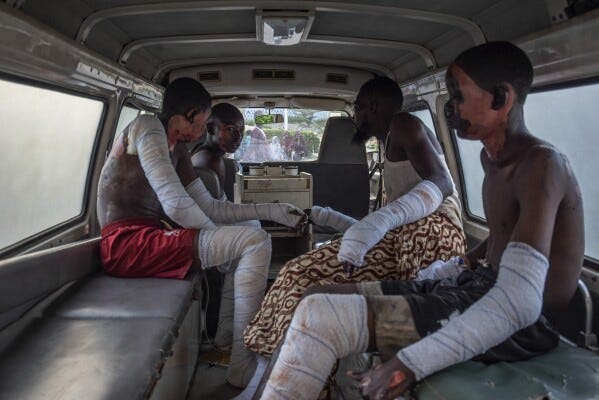
In other words: hundreds of people died because they were poor enough to risk burning to death to obtain gasoline. This, too, is the predictable result of state policy. Nigeria is Africa’s largest oil producer yet the government has steadily raised fuel prices and slashed petrol subsidies since early last year. The price of petrol has accordingly soared up to six times the norm. Tuesday’s explosion came just days after Nigeria’s National Petroleum Company hiked petrol prices for the second time in a month.
So this is the third fire: entirely preventable, entirely predictable. A burning tanker is not a war-crime: it is just the inevitable result of kleptocracy. The nearly two hundred Nigerians who burned to death in Majiya made a single bad wager. They tossed the dice and lost. It was the state that made their world so hazardous. Hollowing its infrastructure, trampling any commitment to public safety, tightening its economic vice grip, the government gave its people nowhere to chance but the blast zone.
The third fire is eternal, burning where one eats and another starves.

